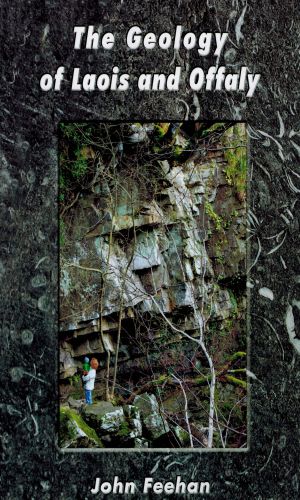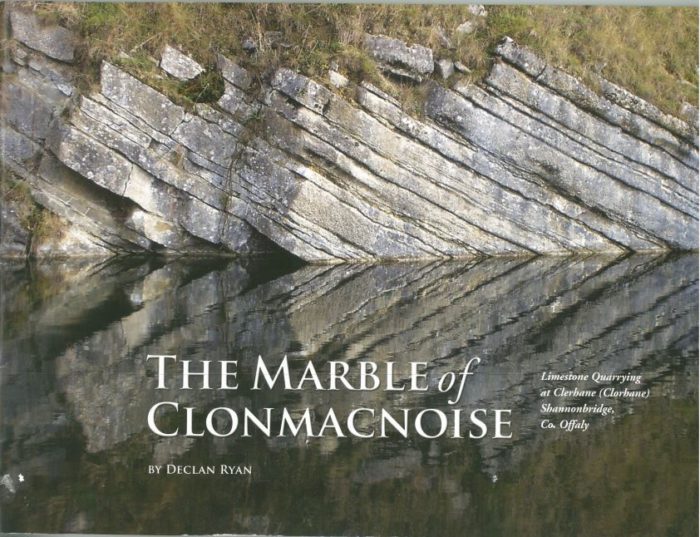The Geological Heritage Audit of County Offaly – 2016
In 2016 Laois and Offaly County Councils worked with the Geological Society of Ireland to carry out a survey of geological sites in the two counties. The audit was carried out by Ronan Hennessy, Robert Meehan, Matthew Parkes, Vincent Gallagher and Sarah Gatley. The Offaly Geological Heritage Project was supported by the Heritage Council, the Geological Survey Ireland and the Offaly County Council. The resulting report was an action of County Offaly Heritage Plan 2012-2016.
Geological Heritage of County Offaly, An Audit, 2016.
The Geology of Laois and Offaly by John Feehan, (2013)

The last thirty years have seen much new research on the geology of Laois and Offaly, shedding new light on – and providing fascinating insights into the landscape heritage of the two counties. John Feehan has remained in close touch with this research since his own work on Slieve Bloom as a post-graduate student in the Department of Geology at Trinity College in the late 1970s and early 1980s.
In this book John now brings all of this research together for a general readership, and relates it to the broader cultural heritage of Laois and Offaly in a chapter that looks at Geology in our Lives. Separate chapters review the story of the two counties through the successive geological epochs that have a bearing on their evolution. A special chapter written in collaboration with Donal Daly of the Environmental Protection Agency (and like John himself a native of Offaly) looks at the Geology of Water. A special feature of the book is the six specially commissioned paintings illustrating different periods in the geological evolution of Laois and Offaly, by Offaly-based artist Jock Nicol, reproduced as two-page full-colour plates.
The Geology of Laois and Offaly is published in hard cover format, some 400 pages long, 21cm x 31cm (Portrait) size, illustrated throughout, in full colour. The price is €40.00 and the book is currently in stock in Midland Books on High Street and Offaly History on Bury Quay in Tullamore.
Geological Videos by John Feehan
The following videos are available to view on the Offaly Heritage YouTube channel.
- Offaly in the Late Devonian
- The Silurian Period in Offaly
- The Ice Age in Offaly
- Offaly After the Retreat of the Glaciers
- The Lower Carboniferous History of Offaly
Brick Making In Pullough (2018 and 2019)
In 2018, Pullough Development Group worked with Waterways Ireland and the heritage office to produce a video about brick making in the 19th and early 20th century in Pollagh.
https://www.facebook.com/WaterwaysIre/
This was followed in 2019 with the publication of The Story of Brick Making in Pollagh, County Offaly by Catriona Devery with the Pollagh Heritage Group. This is a unique story written with the community of Pollagh detailing the evolution of the village as shaped by the brick making industry. The first-hand information has been gathered through interviews over the past decades, combined with more recent research. It provides a wonderful insight into the process of making handmade bricks as well as showing the determination and hard work that was necessary part of survival for Pollagh families in the nineteenth century and beyond. Available through your local library service.
The Marble of Clonmacnoise, Limestone Quarrying at Clerhane, (Clorhane), Shannonbridge, Co. Offaly by Declan Ryan (2013)
The book describes Clorhane townland and the surrounding area and tells the story of the quarries, their owners and the craftsmen who worked there from early records, to their heyday, decline and eventual closure. The type of stone, the work of cutting and carving and the resultant output and the many fine buildings to which they contributed are also examined. Available from your local library service or download the PDF version here.
The Marble of Clonmacnoise, Limestone Quarrying at Clerhane, (Clorhane), Shannonbridge, Co. Offaly

Please note much of the land is in private ownership and permission should be sought from landowners before entering. If in doubt please contact heritage@offalycoco.ie
‘Of the many quarries that operated in Offaly during the centuries before stonecraft declined and almost ended with the arrival of modern concrete, few enjoyed greater prestige than Clerhane, whose crinoidal limestone is one of the most beautiful of Irish building stones. In his meticulous study of the stone industry at Clerhane Declan Ryan has painstakingly salvaged all that survives from oral record and tradition and the documentary record, and set this against the physical background of the quarries themselves and their geographical context. In highlighting the achievement of the quarrymen of Clerhane this lovely book will do much to draw appreciative attention to this aspect of the environmental heritage of one of the most remarkable places in Offaly, and stimulate comparable attention to other facets of that heritage. John Feehan, Syngefield, Birr.
Mining in Offaly
Until recently there were no recorded mines in Offaly. However following the collapse of a mine shaft in Blundell Hill, Edenderry in September 2011, Dr Martin Critchley and Dr Sharon Schwartz have carried out research into this mine which was seeking lead and silver deposits. See their YouTube clip – Offaly Heritage Blundell Mine.
Wavestone / Mushroom Stones
After the last Ice Age, the water table was considerably higher than it is today. Wavestone/Mushroom stone is the name given to a limestone rock which has freeze/thaw marks on it which indicate this water level. Some are shaped like mushrooms, others have an overhang facing in just one direction but all are notched and undercut in such a fashion as to suggest prolonged exposure to standing water at some time in the past. These help us to decipher where the ancient shore lines were.
To find out more about these unusual features of the Offaly landscape see the publication Ireland’s Mushroom Stones, Relics of a Vanished Lakeland by Louise Dunne and John Feehan, (2003). Available in your local library. An updated publication of mushroom stones nationwide is due out in 2024.
Eskers
The last ice age was around 15,000 years ago. Rivers flowed under the ice as the ice began to retreat. These rivers built up jumbled layers of sand and gravel that now form ridges in the landscape called eskers. Other eskers were formed by ribbons of water between the melting glaciers. The sand and gravel in these eskers is sorted. Eskers are particularly evident in Offaly. Knockbarron esker complex close to Kinnitty is a superb example. Roads often travel along eskers for example you will experience this on the road from Boher to Clonmacnoise and along the High Road in Durrow.
Offaly County Council commissioned a Study of Eskers west of Tullamore in 2006 which was carried out by Mary Tubridy and Associates – with support from the Heritage Council.
